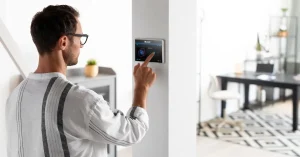Smart Security Systems for Home are becoming an essential part of modern living. These systems use advanced technology to keep your property safe, offering real-time monitoring and remote access from anywhere. They work best when combined with other smart home devices like cameras and sensors, creating a complete protection network for your house.

What Are Smart Home Security Systems
A smart home security system uses connected technology to monitor your property in real time. You can manage cameras, locks, and sensors through a mobile app or voice commands. These systems don’t just detect threats—they help you prevent them. From automated alerts to remote access, smart systems offer convenience and peace of mind, whether you’re at home or away.
Key Devices That Make a Difference
When choosing your home security system, start with the essentials and expand as needed.
Motion Sensors
Detect movement in rooms, hallways, or entryways and send instant notifications to your phone.
Door and Window Sensors
Alert you whenever an entry point opens unexpectedly, keeping your home safe from break-ins.
Smart Cameras
Indoor and outdoor cameras let you see what’s happening in real time, record footage, and even talk through built-in speakers.
Smart Locks
Replace traditional keys with app or code-based locking. Many systems allow you to grant access remotely to guests or service providers.
Additional Add-ons
-
Glass break detectors
-
Smart doorbells
-
Smoke and CO alarms
-
Outdoor motion lights
A well-chosen combination of devices strengthens your home’s overall protection and makes the entire system more efficient.
Wired vs Wireless Security Systems
Understanding the difference between wired and wireless setups helps you make the right decision for your home.
Wired Security Systems
-
Require professional installation
-
Operate through electrical connections or landlines
-
Stay functional even without Wi-Fi
Wireless Security Systems
-
Easy to install on your own
-
Work over Wi-Fi and often include mobile control
-
Usually costs less and can be expanded later
For flexibility and convenience, most homeowners now prefer wireless smart security systems.
Installation Tips
Setting up a smart home system doesn’t need professional help if you follow a few key steps:
-
Plan where each sensor and camera will go.
-
Follow the manufacturer’s setup guide in the mobile app.
-
Test every component before finalizing installation.
Modern systems are designed for DIY setup, making it easier for users to customize and manage their home security.
Protecting Your Privacy
A secure system should also protect your personal data. Follow these best practices:
-
Use unique, strong passwords
-
Turn on two-factor authentication
-
Keep apps and firmware updated
-
Store backups locally or on encrypted drives
Good smart security systems balance convenience with strong privacy protection, ensuring your footage and alerts remain confidential.
Choosing the Right Smart System
Selecting the right security system depends on your priorities and living situation.
Budget
Decide on your upfront spending and whether you’ll need ongoing monitoring services.
Simplicity
Consider how comfortable you are with installation. Wireless systems are generally easier for beginners.
Customization
Some systems let you automate lights, locks, and alarms to fit your lifestyle. Pick one that suits your daily routine and space.
Expert Tips
-
Teach all family members how to use the system.
-
Install the companion app for remote access.
-
Integrate with Alexa or Google Assistant for easier control.
These small steps make your home security system more practical and user-friendly.
Recommended Brands
If you’re new to smart home protection, start by exploring trusted brands such as:
-
SimpliSafe
-
Ring
-
Google Nest
-
Vivint
-
ADT
Each brand offers unique pricing, devices, and monitoring options. Compare before you buy to ensure the system matches your home’s layout and budget.
Final Thoughts
Smart security systems aren’t just tech gadgets—they’re about real peace of mind. After testing different setups, I’ve learned that choosing the right system depends on your lifestyle, budget, and the level of control you want. With the right mix of devices and planning, securing your home becomes effortless.
If you’d like to explore more expert comparisons and insights, check out this comprehensive guide on smart home security systems by TechRadar. It’s a great resource to understand how different brands stack up and which one might be the best fit for your home.
Frequently Asked Questions
1: What is a smart home security system?
It’s a connected setup of cameras, sensors, and locks that you control through Wi-Fi using a mobile app.
2: Is wireless better than wired security?
Wireless systems are easier to install and expand, while wired ones are reliable for long-term use.
3: Can I install a system myself?
Yes. Most wireless systems include clear instructions for self-installation.
4: How do I keep my system secure from hackers?
Use strong passwords, enable two-factor authentication, and update software regularly.
5: Which brands are most popular?
Top-rated brands include SimpliSafe, Ring, Google Nest, Vivint, and ADT.
